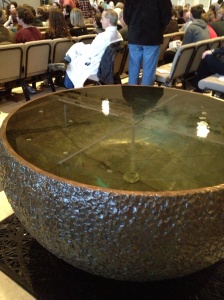The first half of Ezekiel’s 47th chapter is about one topic: a vision he had concerning a flow of water. This is a favorite passage for preachers as it contains much symbolism which can be developed in diverse ways. He notices a flow of water coming out of the temple. Just a trickle at first. The farther it goes, the deeper it gets. First ankle deep, then up to the knee. Farther out, it was up to the waist. Farther still, it became deep and wide enough to swim in, but was too big for anyone to cross. What started as a trickle had become an ocean.
Now this is contrary to what one would normally expect to see. If you have a swimming pool in your yard which needs to be emptied, you start with water, lots of water, multiplied gallons of water. Letting it flow out, you would expect that the farther away you get from the source, the smaller the size of the stream as it finds its way down the street, until finally there is no more.
With God there is always the unexpected, and there is always His desire for increase. This river pictures the New Testament revelation of the Kingdom of God. “What is it like?” Jesus asks. It is like that little bit of yeast in the dough, or like the tiny mustard seed which grows to become large enough for birds to roost in. It starts small and grows exponentially. Life from God will bring multiplied numbers across multiplied miles. First in Jerusalem, then Judea, Samaria and the uttermost parts of the earth.
As the revelation continues, Ezekiel sees “a great number of trees” on both banks of the river. Planted trees are symbolic of people, His people. (Isaiah 61:3; Psalm 1:3) The Life-Giving Flowing River now supports life in large number.
It continues on through the Arabah and on to the Dead Sea. The word Arabah denotes “the generally sterile valley of the Jordan.” Sterile, dead. Nothing grows, nothing lives on land or sea. Yet, when the River of Life flows in something happens. When it empties into the Sea, the water there becomes fresh. Swarms of living creatures will live where ever the river flows. There will be large numbers of fish, because this water flows there and makes the salt water fresh; so where the river flows, everything will live. vs.9
Please note “swarms” and “large numbers.” There is nothing stinting about God. It is all about greatness, increase, life. There are creatures on the once sterile land and fish of many kinds in the sea. Variety has always been a hallmark of the Creator.
Then he describes the trees. Not only is there a great number, but now he says they are fruit trees of all kinds, growing on the banks of the river. Because of the life-giving river, the trees are fruitful every month. There is no dormant period. They bear every month, producing food for all. The fruit never fails where the river flows!
All those fruit bearers are His people, His varied people. With each producing different fruit, every person’s need will be met there somewhere. If not this tree, then that one will do because His intention is that all will be productive, and all will receive nourishment sufficient to their needs from His life. If we abide in him (John 15:4-5) there is much fruit.
In addition to the fruit, these trees’ leaves have a purpose. Nothing is wasted in God’s Kingdom. The leaves, which never wither, are for healing. Healing! Restoration to the original good design. Back in balance, order, alignment, harmony. The cry of our hearts is always for healing – spirit, soul and body, to know and experience life in its fullness without malfunction, sickness and disease. Yet here it is clear that it is the very people of God who will have the answer to that cry. It is those touched by the river of life who have something within them to bring healing where needed. And that something never gets old. There are not a few special trees which have healing leaves; every tree has them.
This entire scene is a picture of inclusion and productivity, purpose and abundance. No one is left out, none is useless. This message is the same as that brought to Israel by Jesus when he proclaimed the Kingdom of God. It is His main message, the reason that He came. (Luke 4:43) God is near you; rejoice!
The vision in Ezekiel is a somewhat similar parallel to a scene at the end of Revelation. To compare and contrast them is enlightening. Rev 22:1,2 Then the angel showed me the river of the water of life, as clear as crystal, flowing from the throne of God and of the Lamb down the middle of the great street of the city. On each side of the river stood the tree of life, bearing twelve crops of fruit, yielding its fruit every month. And the leaves of the tree are for the healing of the nations.
Here the river is flowing in the very center of God’s perfect heavenly new creation. Flowing from the throne of God and the Lamb, and a bringer and sustainer of life, this river pictures the Spirit arising from Father and Son, and central to the city and His life. Verse 2 says that on each side of the river stood the tree of life! THE tree (singular) stands on both sides of the river. In the earlier vision, there were trees of many kinds; here it is one tree, yet on both sides. In our present world, a tree divided in two would fall and die. Obviously our view and understanding have to change here. The new scene has replaced all the varied trees representing all kinds of people with the tree of life, that very tree which was blocked to man after the Fall.
This tree, the tree, which bears fruit month by month covering all seasons. also has leaves for the healing of the nations. These leaves are designed to cleanse away all that defiles, sickens and separates. There is no people group, no ethnos which cannot be restored to the new creation. The provision is in God, supplied by God, sustained by His very Spirit or life-giving essence. Healing is the result of abiding in Christ, letting the Spirit of the Living God flow through us like a river.
Jesus is the Tree of Life on the banks of God’s river of life. The triune God dwells within us, according to John 14:20,23,16. Therefore, releasing His life to others rises from a true relationship with Him.
As we earth-bound humans become yielded to God, and conformed to the image of Christ, are we not then being transformed into Trees of Life? The fruit of our lives is not our manufacture, but arises from the tap root and DNA of the tree itself. Our continued walk of holiness and righteousness, based on the leafy cleansing of Holy Spirit witnesses truth and reality to all “nations” we contact.
Of course, on this side of the new creation, it is both now, and not yet. We are becoming life-givers, but not yet what we will be. As the River flows on, deepening, sustaining, changing all that it touches, we are becoming. Let that River flow.



